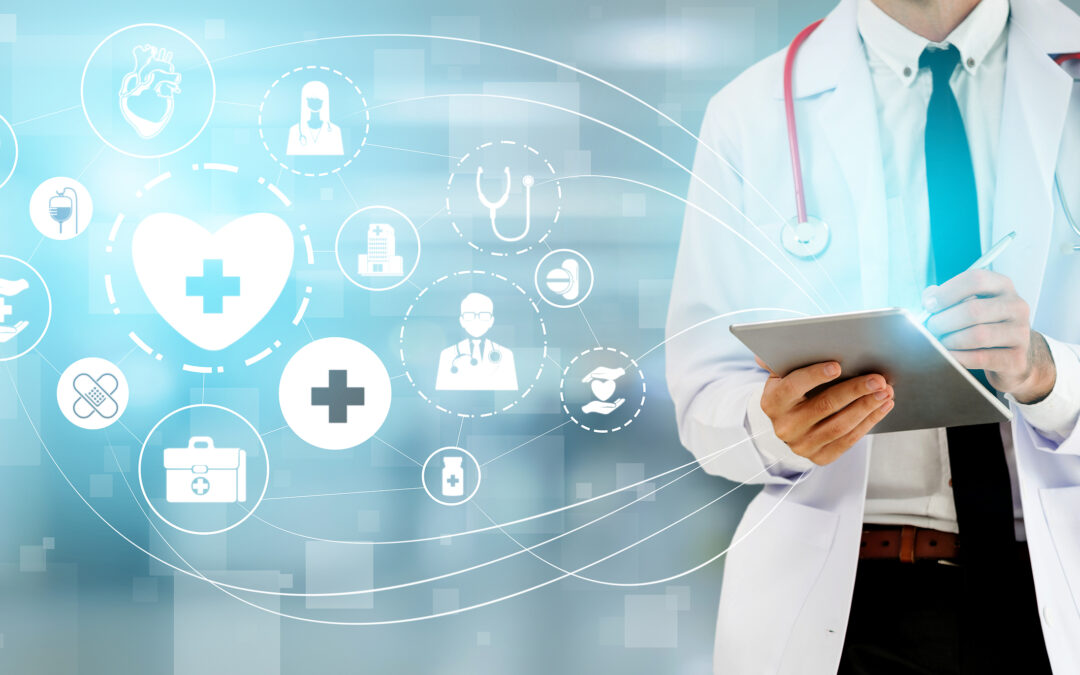Artificial Intelligence (AI) and machine learning (ML) are not mere trends in healthcare; they have become vital tools in the industry. As telemedicine gained widespread acceptance during the COVID-19 pandemic and healthcare costs rose alongside patient volumes, the transformative potential of AI and ML in revolutionizing the medical sector has become apparent.
With many providers still struggling to fill empty positions, technology could help ease the burden on healthcare workers while enhancing the patient experience. Additionally, data is central to positive outcomes in healthcare, from patient care to employee productivity and operational efficiency. AI and machine learning are vital tools for doctors to manage, analyze, and share this information efficiently and effectively.
What Artificial Intelligence and Machine Learning Mean for Healthcare
First, a couple of quick definitions: Artificial intelligence in healthcare uses algorithms and software to sort, analyze, and present complicated medical data efficiently. Leveraging machine learning, AI gets “smarter” over time, improving performance based on continuous input and feedback. Natural language processing (NLP) allows these programs to understand written and spoken text – such as visit notes or phone messages – in ways similar to humans.
Healthcare Technology and AI in the Global Market
Medical technology is a massive market. Worldwide revenue for clinical devices and products is forecasted to reach $579.40 billion in 2023 and $701.90 billion by 2027, with a compound annual growth rate (CAGR) of 4.91% overall. The United States holds the largest market share in this segment, with
$199.80 billion in revenue expected in 2023. Medical technology revenue in the United Kingdom is also expected to see steady growth, with a projection of $19.65 billion for 2023 and an anticipated CAGR of 3.83% between 2023 and 2027.
While healthcare technology continues to grow steadily, the AI segment is booming. The global market size for AI in healthcare was estimated to be $15.1 billion in 2022 and is expected to expand to $187.95 billion by 2030 with a CAGR of 37%. Although North America held 58.1% of the market share in 2021, the Asia Pacific region will proliferate, with a CAGR of 30.7% through 2030.
High volumes of remote and in-person patient admissions, on top of worldwide labor shortages, drive AI’s rapid growth in medical and healthcare settings. Each entry requires steps and generates data that AI can help analyze and process, including:
- Storage and management of digital health records
- Scheduling tests, procedures, and follow-up appointments
- Prescription tracking and refills
- Referral handling
- Filing and managing insurance claims
- Ongoing tracking and care for chronic diagnoses
Healthcare leaders are prioritizing investments in AI technology, and these investments will only grow in the future. In 2021, 19% of healthcare leaders were focused on investing in AI to optimize operational efficiency. Still, that number is expected to double by 2024 — furthermore, 40% plan on investing even more in predictive AI technologies in the next few years.
Learn how CRI can improve healthcare communications
Applications for Artificial Intelligence and Machine Learning in Healthcare
AI technology is becoming intricately linked to the healthcare system, from patient portals and billing to digital imaging and diagnostics. Every interaction generates data, whether in text documents or image files, in electronic health record (EHR) systems.
Previously, making sense of that disparate information would have required a human to access and read through every record. AI with ML and NLP capabilities uses algorithms to rapidly sort through complex data in a fraction of the time, identifying patterns and delivering insights to providers.
An integrated unified communications system purpose-built for healthcare works hand-in-hand with AI and ML to promote constant collaboration and communication, improving quality of care, expanding clinical capabilities, and reducing costs. Unified communications (UC) for healthcare facilitates connections between patients, medical professionals, and researchers. Each contact center interaction, appointment reminder, or trial response contributes data points for AI to mine.
AI, ML, and unified communications are helping healthcare organizations overcome some of the biggest challenges.
Automating Administrative Tasks
Most healthcare processes these days involve essential but repetitive tasks:
- Sending appointment reminders
- Processing insurance claims
- Filling out billing codes
- Analyzing medical records
These take up significant employee time but don’t require much critical thinking.
On the other hand, AI excels at rapidly processing massive volumes of unstructured data. ML and NLP easily analyze abstract information from EHRs and synthesize it into manageable reports for humans to interpret. With EHR data in the cloud, AI can easily do things like:
- Manage patient communications
- Collate patient records across different databases
- Arrange appointments and staff schedules
- Match patients to providers
- Send prescriptions to pharmacies
- Request (and document) patient feedback
EHRs often contain sensitive information and may require certifications for certain people to view. AI removes this barrier, protecting patient privacy while promptly delivering documents to the correct person.
Many essential clinical communications can be managed efficiently from a healthcare-focused UC interface. AI and integrated communications and collaboration systems minimize the opportunity for human error while also reducing costs. Streamlining workflows means employees can focus on higher-value patient interactions that contribute to a better quality of care.
Improving the Patient Experience
Modern healthcare, often conducted remotely or rapidly to process as many cases as possible, can seem cold and unwelcoming. Patients who feel they’re being treated as a number rather than a person are less likely to return for medical care and are more likely to relapse.
Incorporating AI into the patient journey leads to more positive clinical outcomes and higher patient satisfaction. From patient portals and telemedicine to wearable devices and remote monitoring, technology connects patients to doctors 24/7. With direct access to their healthcare from any device, patients have more authority over their own experience.
AI with NLP, such as programs based on ChatGPT, can manage basic communications, helping with simple requests or redirecting to a human agent for more information. AI software can instantly access patient information and deliver accurate responses in a personalized manner.
Remote patient monitoring improves outpatient services, letting patients recover in the comfort of their own homes. AI tracks patient wellness through internet-connected devices, giving doctors continual updates on patient vitals and alerting them immediately if something changes. Off-premises treatment and recovery reduce the cost of in-hospital stays for patients and facilities.
Unified communications solutions work in tandem with AI to further enhance patient care. For example, integrated voice response (IVR) technology can automate responses to routine inquiries around the clock,
ensuring patients can access the information and assistance they need. Click-to-chat and click-to-call capabilities within patient portals improve response times.
CRI is Here to Help You Improve Your Patient Experience
Enhancing Employee Productivity and Satisfaction
AI and ML can assist everyone from insurance coders and front desk staff to doctors, physicians, surgeons, and nurses. Although the medical practice is still best left to the professionals, AI and ML can assist in clinical decision-making and improve productivity.
For example, a doctor or imaging specialist could upload an X-ray image to a diagnostic AI, which would use pattern recognition to identify markers of a particular disease. NLP technology could run notes from an exam against medical databases and suggest a course of treatment.
Machine learning can help make diagnoses more accurate because the technology is constantly updated with the latest research. Predictive analytics can synthesize documents, studies, and raw data to identify trends and predict outcomes faster than humans. The results can then be assessed and turned into personalized treatment plans by a provider.
Healthcare workers are often overworked and overwhelmed, especially with high patient intake. AI-assisted UC mobile apps put workflows and communications in providers’ hands in the OR, clinic, or nurse’s station. With quick access to patient information, they can spend less time searching for documents and more time treating their patients. Secure integration capabilities into existing health information technology systems allow caregivers to seamlessly collaborate through the chain of care, saving time and optimizing workflows.
In a field where bedside manner matters just as much as clinical proficiency, AI and unified communications enable caregivers to perform their best.
CRI: Your Parnter in Unified Healthcare Communications
AI and ML are more than just technology; they’re critical partners in the modern healthcare experience. Integrating AI into everyday medical practice improves clinical outcomes by providing data-driven support for patients and providers.
CRI’s healthcare communications solutions leverage AI to streamline workflows and automate repetitive tasks. From triaging patient calls through the Contact Center to coordinating schedules with workforce optimization software, CRI enhances the patient and provider experience.
Working with us is easy. Simply fill out a form and we’ll reach out to you with next steps.

